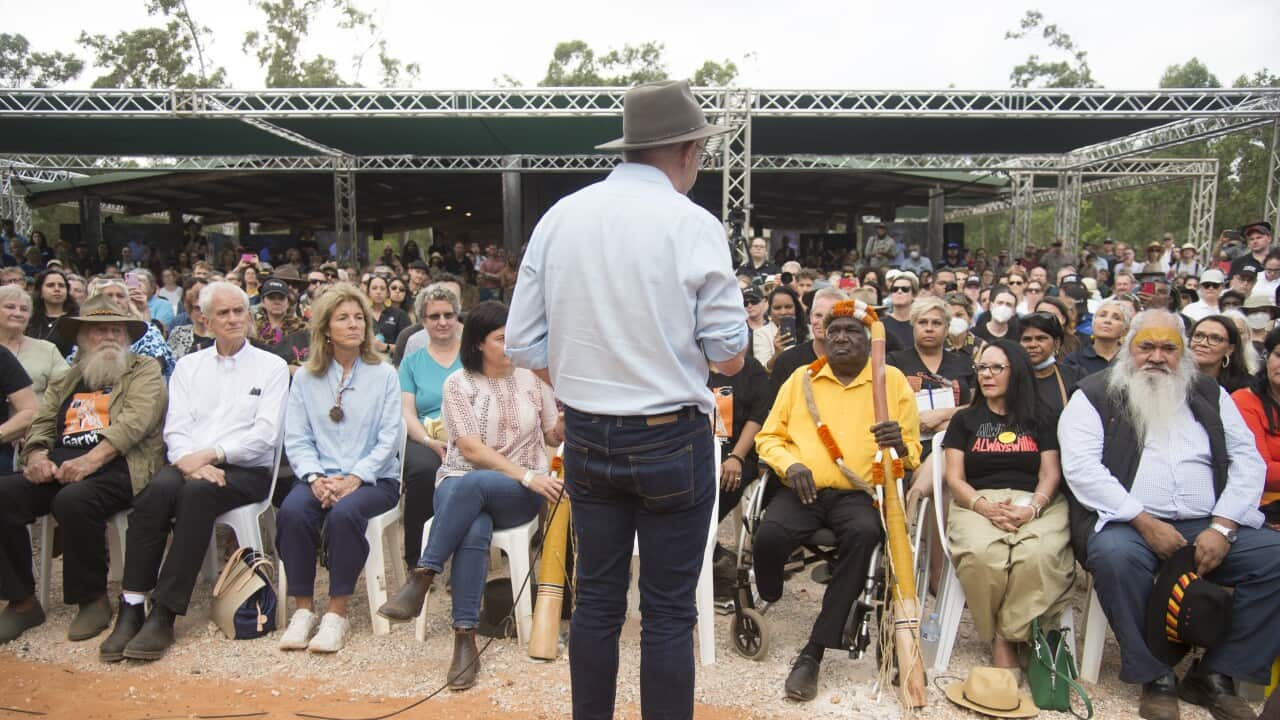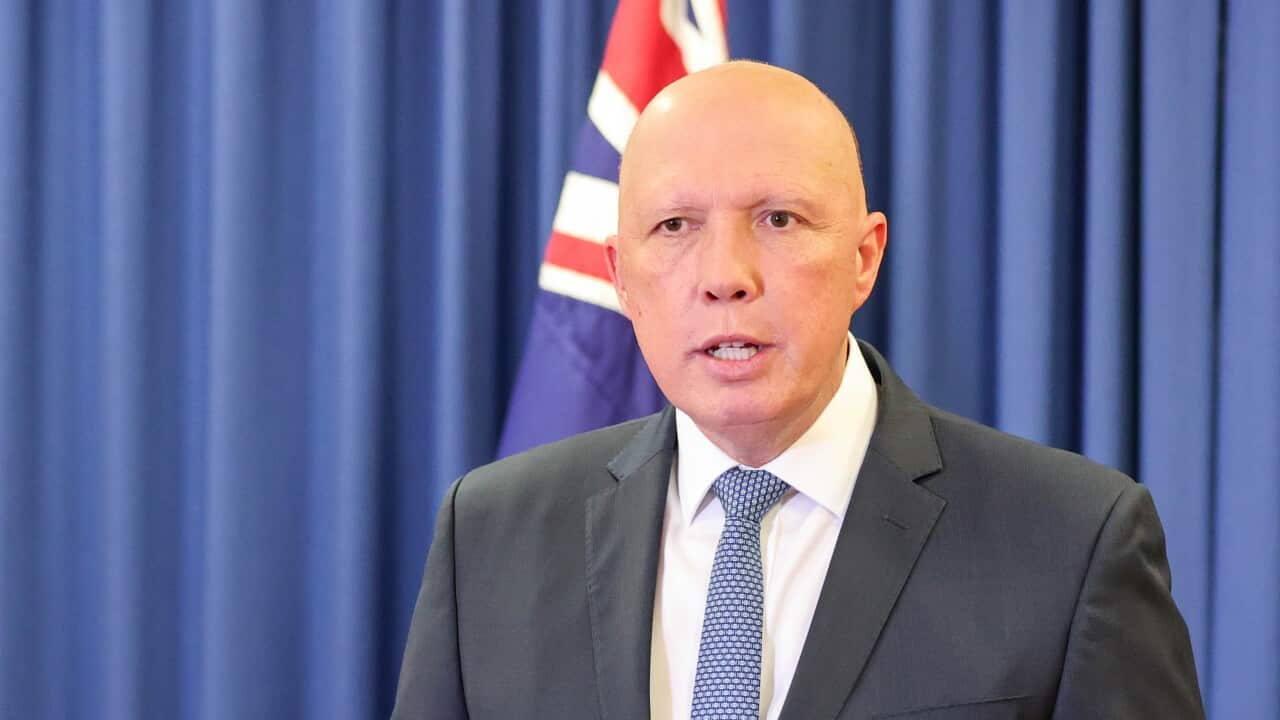Key Points
- The 2017 Uluru Statement From the Heart calls for Voice-Truth-Treaty, in that order.
- Whether the Voice referendum will kick off a federal Treaty process has recently become a hot political issue.
- There are overseas examples of treaties with First Nations peoples, in countries such as New Zealand and Canada.
Just months from a vote on an Indigenous Voice to Parliament, the Opposition is pressing Labor on the prospect of a treaty with First Nations Australians.
The Voice was first called for in the 2017 Uluru Statement From the Heart, which also flagged truth-telling about Australia's history, and a process for treaty with Indigenous people, to follow the Voice.
Prime Minister Anthony Albanese's first words on election night committed Labor to implementing the Uluru Statement "in full", but he has recently stressed this year's referendum is about the Voice only.
A Yes vote would not automatically kickstart a treaty process, and that process could begin regardless of the referendum outcome.
But the Coalition is accusing Albanese of hiding his true intentions, with Opposition leader Peter Dutton claiming he has "continually denied that there will be a treaty".
So what does the Uluru Statement actually say about a treaty, are there First Nations treaties overseas, and what's being done at a state level here?

Prime Minister Anthony Albanese has previously committed to implementing the Uluru Statement in full - including a Treaty. Source: AAP / Aaron Bunch
What is a treaty?
A treaty is a formal and legally binding agreement struck between two or more parties, usually involving at least one sovereign state.
No treaty has ever been signed between the Commonwealth and Indigenous nations. In 1998, the-prime minister Bob Hawke promised to negotiate a treaty with First Nations Australians by 1990, a pledge that he didn't fulfill.
There are roughly 500 separate Aboriginal peoples in Australia, each with their own language and territory, according to Survival International.
Given the complexity of the situation, some advocates believe a national treaty here could take decades to negotiate.
What does the Uluru Statement say?
The Uluru Statement references Makarrata - a Yolngu language word meaning "a coming together after a struggle".
But the Statement doesn't specify that any treaty needs to be made at a federal level; it only calls for the supervision of treaty processes with "governments", which could potentially mean the states.
"We seek a Makarrata Commission to supervise a process of agreement-making between governments and First Nations and truth-telling about our history," it reads.
"It captures our aspirations for a fair and truthful relationship with the people of Australia and a better future for our children based on justice and self-determination."
What's happening in Australia?
Albanese has recently stressed that, while the Commonwealth is focusing on the Voice, treaty processes are already in motion at a state level.
Pressed on whether he supports a treaty, he told ABC radio: "That's [already] occurring. That's like saying, do you support the sun coming up?"
The Queensland government introduced a bill to parliament this month that would create a First Nations Treaty Institute, .
Victoria established an independent treaty authority last year to act as an "umpire" during negotiations, which are set to start this year.
South Australia also started treaty talks with three separate Indigenous nations in 2017.

Independent senator Lidia Thorpe wants a treaty before a Voice to Parliament. Source: AAP
There is some controversy over that. Some First Nations people want a treaty to be the first step, to reflect that their sovereignty was never ceded. That view is reflected in parliament by independent senator Lidia Thorpe. Her former party, the Greens, have also expressed a preference for that order but are now supporting a Yes vote for the Voice.
But many advocates say it's hard to see how a national treaty could be struck without a Voice, which could represent Indigenous Australians during negotiations.
What about treaties made overseas?
In 1840, the British Crown and a large number of Māori chiefs signed the Treaty of Waitangi, which the New Zealand Justice Department says is "widely accepted to be a constitutional document that establishes and guides the relationship between" the two parties.
The agreement included a pledge to protect Māori culture, while granting the Crown the right to rule over what would later become New Zealand. Rights set out in the Treaty can only be enforced if a New Zealand law makes explicit reference to it.
Any Māori can also appeal to a separate body, the Waitangi Tribunal, to argue that they have been disadvantaged by a law or practice of the Crown. The tribunal cannot enforce laws but, as advocates of the Voice to Parliament in Australia propose, has the power to make recommendations to the government.
Canada has also reached around 70 treaties with First Nations peoples since 1701, some leading to self-governance. Those treaties are administered by national and provincial governments.
In the US, around 370 treaties signed before 1871 have been ratified. But most have been broken, while some have been used to force original owners from their lands. The treaties are administered federally.
The Nordic region's Indigenous population — the Sami people — have long had their own parliaments in three separate countries: Finland, Sweden and Norway. But a decade-long negotiation resulted in a unified Nordic agreement on the rights of Indigenous peoples in 2017.












